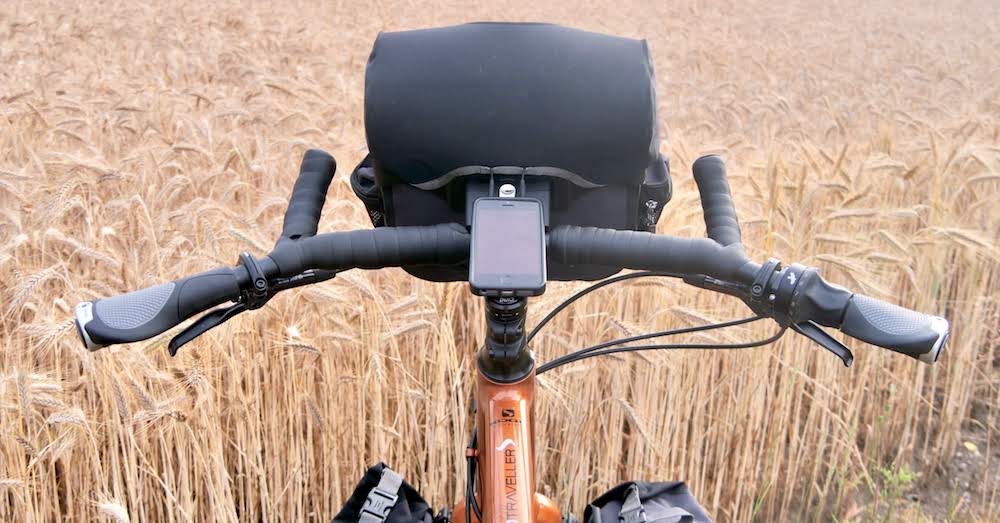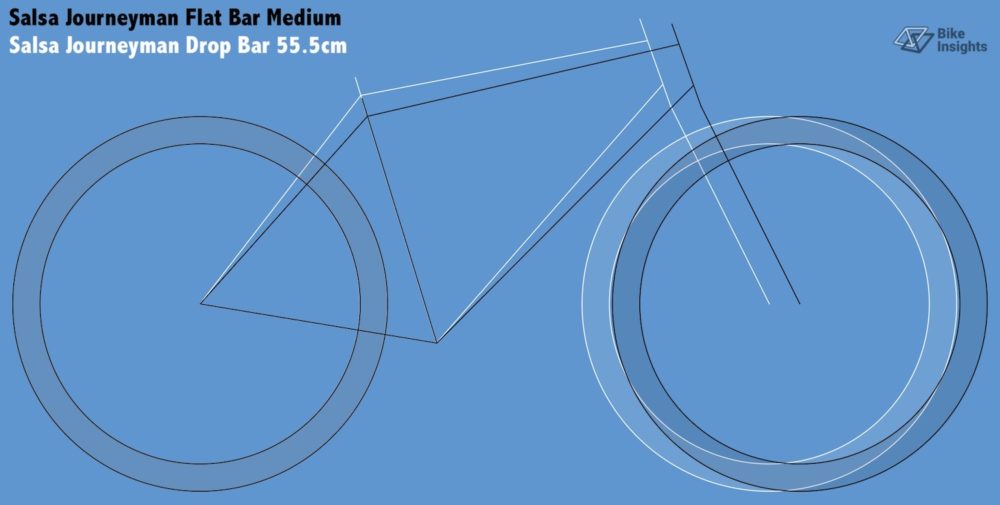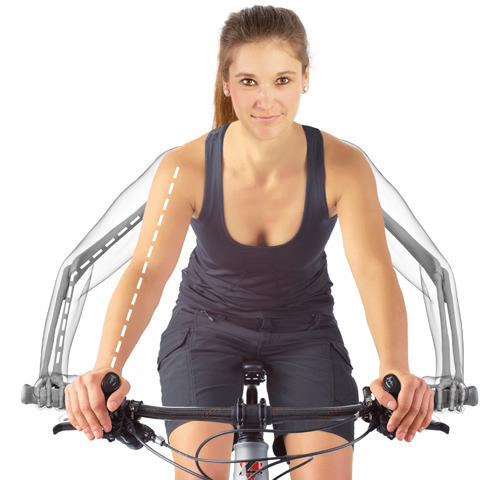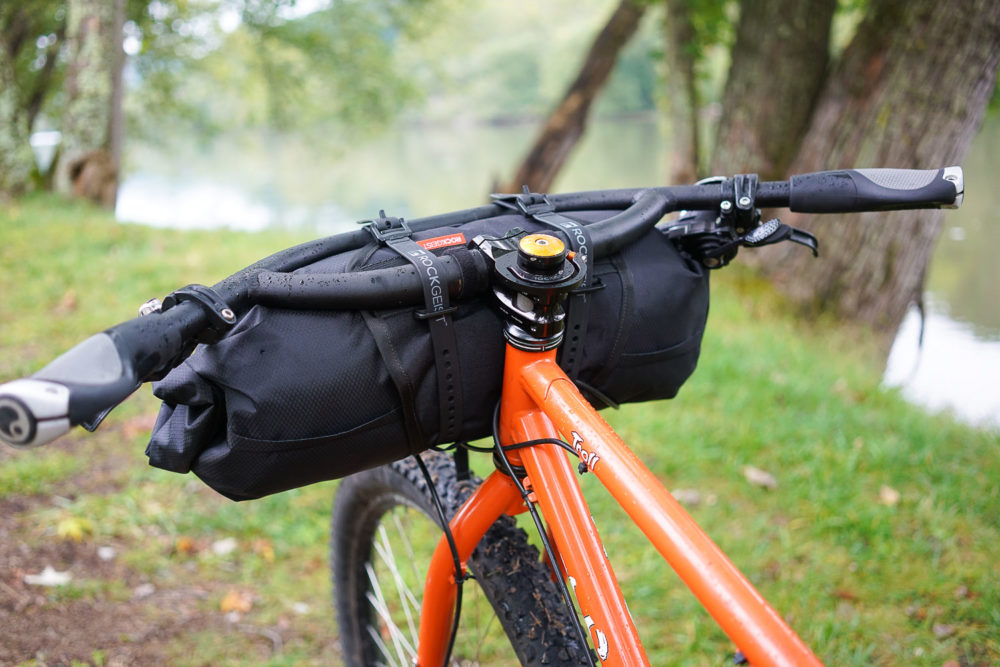Alt bars are a type of handlebars that are designed specifically for long-distance cycling. They typically offer a broad variety of hand positions, riding postures, and accessory mounts. In addition, you’ll gain extra steering leverage for better control over your loaded bike.
Alt bars are suitable for those who are touring on paved and dirt roads, along 4×4 tracks, down singletrack trails, through unkept fields, and across everything in between.
With the varied hand positions of these handlebars, you’ll not only get to change the pressure points in your hands throughout the day, but you’ll activate different muscles in your arms and back too. Alt bars ultimately help you to look after your body on long rides.
A comfortable alt bar setup might even give you the power to cycle more miles, recover quicker, and enjoy more of the scenery while riding.
Many of the alt bars I recommend in this article HERE will help you achieve a more upright riding position. This is usually accomplished by reducing the distance between your saddle and the grips via large backsweep angles, a long backward reach, and a tall handlebar rise – you’ll learn about these terms in a moment!
Alright, let’s find out how to choose the most comfortable alt bars for bikepacking and touring.
Upright Riding Positions

The first thing you need to consider is how upright your riding posture is, and whether it would be beneficial to set your grips even higher.
Your core muscles fatigue on long rides, so most people end up putting more weight onto their hands as the hours go on. By increasing your handlebar height, you can keep the load on your hands at an acceptable level.
In addition, a more upright riding posture usually reduces strain on the neck, shoulders and back, and you tend to look around more at your surroundings.
The primary downside of an upright posture is a less aerodynamic riding position, but you can still rocket along if you fit some aero bars onto your alt bars (highly recommended).
A great starting point for a comfortable alt bar setup is setting your handlebar level with your saddle. You can do this by selecting a bar with a tall rise. If a tall bar setup is new to you, make sure to give it some time for your body to adapt as it might feel a bit strange at the start.
It’s worth noting taller riders will often tolerate a lower handlebar compared to shorter riders as they have longer limbs relative to their torso length. Riders with a strong core tend to also tolerate a lower bar. That said, individual variations exist, and not everyone fits these general patterns.
And a downstream effect of fitting taller bars is that you might also need to swap to a more padded saddle (as you now have more weight on your butt!).
Ok, you should now have a good idea about handlebar height, so let’s discuss the ideal backsweep angle.
Alt Bar Backsweep Angle

Alt bars use larger backsweep angles than typical MTB handlebars. This helps to preserve the natural wrist position of a more upright riding position, reducing finger numbness (which often arises from overstretching your wrist).
I consider:
Small backsweep angles to be 5 to 12 degrees <- almost all MTB bars
Moderate backsweep angles to be 12 to 25 degrees
Large backsweep angles to be 25 to 35 degrees
It’s instantly noticeable going from a flat MTB bar with a 5-12 degree backsweep angle to the 20+ degree backsweep angles of most alt bars.
The perfect backsweep is determined primarily by your ride posture, but also core strength, grip choice, and glove choice. There’s a healthy dose of personal preference in there too.
The more upright and relaxed your body posture, the more backsweep angle you will likely find comfortable. This is because your elbows will naturally pull in closer to your body, changing both your wrist angle and the interaction between your hands and grips.
Conversely, smaller backsweep angles generally suit lower, performance-oriented body postures as your elbows naturally sit wider (see animation above).
If you were to use a large backsweep angle with a low riding posture you’ll likely find your hands naturally want to rest diagonally over your grips, creating pressure points on your palms.
Here are my backsweep angle starting points:
- 5 to 15° will feel most comfortable if your handlebar is lower than your saddle
- 15 to 25° will feel most comfortable if your handlebar is around the same height as your saddle
- 25 to 35° will feel most comfortable if your handlebar is significantly higher than your saddle
If you’re not sure where to land, I’d recommend starting with a bit less backsweep angle, rather than more. The 15 to 25° range is a great start.
Alt Bar Rise

To achieve a comfortable setup for long-distance riding, you should also consider using alt bars with extra rise, which will allow you to sit a bit more upright.
Handlebar rise is measured from the centre of the handlebar to the bar end. Some bars in this resource have zero millimetres of rise and others have over 100mm of rise (4″).
Additional bar height can also be achieved via your stem or by using a steerer extender.
Keep in mind that the ideal backsweep angle will likely need to increase along with the bar height.
Alt Bar Width

Wider handlebars provide additional steering leverage. This results in better control over heavy-loaded bikes on rough trails.
But wide bars also make splitting traffic, getting through doorways, and riding in tight singletrack more difficult. I’ve found that 700 to 730mm is my sweet spot between bike control and travel practicality. But if I spent less time in urban areas, I would likely prefer something closer to 800mm.
Please note that you can cut down all handlebars to size; manufacturers will usually have a minimum recommended width. Just make sure there is enough space on the grip sections to install your shifter(s) and brakes where you like them first – 200mm is about as short as you can practically go.
Also, keep in mind that wider alt bars increase the effective distance to the bars from the saddle. This means you might need to compensate by using a shorter stem or fitting a bar with a long backward reach…
Backward Reach

A handlebar with a large backsweep angle usually brings your handlebars closer to your body, putting you in a more upright ride position. But it isn’t always the case!
You also need to look at the handlebar’s overall design to determine whether it has a long or short backward reach. Does it swoop forward before starting its backsweep like the Surly Moloko, or swoop backward right from the stem clamp like the KOGA Denham Bars?

Handlebars with a long backward reach (eg. KOGA Denham) will put you in a more upright position by reducing the distance from your saddle to your grips. Conversely, handlebars with a short backward reach (eg. Surly Moloko) will allow you to maintain a body position similar to a flat bar.
One important thing to note about long backward reach handlebars: they are not suitable for all mountain bike trails. This is because they can slip and rotate in the stem clamp after a big impact (eg. rock drop). That said, I regularly ride on singletrack; I just make sure to avoid jumps or drops that could cause my bars to slip.
Alt Bar Stem Length

The length of the backward reach also needs to be considered along with your stem length.
To a large degree, you can use stem length to place your grips in the perfect location. But this might require changing your stem length by 30 to 60mm, depending on what riding position you’re looking to achieve.
In some circumstances, you might need to use an especially long stem to get your grips in the ideal position. For example, if you want to fit a handlebar with a long backward reach to a drop bar frame, a 130 or 140mm stem might be required.
Alt Bars and Frame Design

Another thing to consider is the handlebar design that will best pair with your frame.
A flat bar frame (like a mountain bike) is usually the best option for a handlebar with a long backward reach. This is because flat bar frames are usually longer than drop bar frames (by ~50mm), so they will likely accommodate a handlebar with a large backsweep angle and long backward reach.
A drop bar frame (like a road bike) is usually the best candidate for a handlebar with additional forward reach. This is because drop bar frames are usually shorter than flat bar frames, so you’ll want some forward reach to make sure the grips aren’t too close to your body.
Alt Bars For Drop Bar Frames

The most suitable alt bars for a drop bar frame either have a small backward reach or none at at.
There are also alt bars that have been designed specifically for drop bar conversions. These unique handlebars have a large forward reach, allowing you to place your hands slightly in front of the stem clamp.
The Curve Remlaw preserves the hand position of a drop bar without requiring a different length stem. They might even save you a bit of money as you might not need to buy a longer stem.
WhatBars Comparison Tool

A really cool tool for comparing alt bars is WhatBars.
You’ll find many handlebar options in there. Simply select a few bars and the tool will allow you to visualise and compare their geometry and grip locations.
Fitting Inner Bar Ends To Alt Bars

If you like the idea of the ‘bullhorn’ hand position found on the Crazy Bars or Denham Bars, you can find component manufacturers that create clip-on versions.
This hand position is not only more aerodynamic, but it puts different pressure through your hands, and changes the load through your wrists, arms, back and neck.
An internal study by SQlab showed that these inner bar ends can save 14 watts of power output at a speed of 36 km/h (280 watts). This is simply because these inner hand holds put your body in a more aerodynamic riding position.

The Soma Bar Ins Extensions are a great choice as you can choose your clamp location, extension length, and even the inward and upward tilt angles. There is a short (95mm) and long (150mm) bullhorn available.
The Bar Ins clamps angle the extensions inward about 25°, so the extensions would stick straight out on a 25° backsweep alt bar. If you wanted to match the 7° inward bullhorn angle of the Denham Bars, you would need to find an alt bar with an 18° backsweep angle.

Spirgrips are a more performance-oriented product that’s designed to sit next to your grips. They are much shorter and lighter than Soma Bar Ins and are shaped to cup your hands well. They are angled inward to ensure your wrists engage with your bars at a suitable angle.
The SQlab Innerbarends 410 2.0 are another great option, and these best fit right next to your grips. A cool feature is that you can integrate them directly with the lock-on SQlab grips, removing one of the grip clamps. The only downside is that compared to the Bar Ins, you’ll have less ability to tune the angles.
You can, of course, use any regular bar ends too. The only downside is that they’re not usually designed for sweptback handlebars so you might find they angle outwards rather than inwards.
Alt Bar Materials

Alt bar manufacturers offer a broad range of materials including aluminium, steel, titanium, carbon and even bamboo.
The best alt bars for most riders are made from aluminium, which balances cost, weight, comfort, and durability in equal measure. However, other materials are becoming increasingly common in alt bars for various reasons.
To generalise:
– Steel alt bars are known for their durability but they’re heavy
– Carbon handlebars are strong and lightweight but they’re less forgiving to crashes and rough transit
– Titanium handlebars are durable and lightweight but also quite expensive
I’ve listed a bamboo model in my best alt bars article as I found it to have a shocking amount of compliance built in. You can see it deflect a couple of centimetres just by pushing down on it – there is a video of this flex in my article.
Alt Bar Grips

Your grip choice is arguably just as important as the alt bar itself.
One of my top recommendations for alt bar grips is thick silicone grips. These super soft grips will not only damp vibration coming up from the road or trail but conform nicely to your hands.
My two favourite silicone grips are the Wolf Tooth Fat Paw lock-on and ESI Extra Chunky.
My other recommendation is grips with a shaped design. These grips have been optimised for large backsweep angles, which allows your hands and wrists to sit at a very natural angle. These grip designs also often have a ridge in the middle that cups inside your palm, and a rearward wing that distributes hand pressure across a larger surface area.
Look out for the Ergon GC1, XLC GR-S22 or SQlab 710 for an extra comfortable design on a handlebar with lots of backsweep angle.
Handlebars and Bags

And lastly, make sure to think about how your luggage will integrate with the bars you choose.
A wide straight section next to the stem is ideal for mounting bikepacking handlebar packs (eg. Revelate) and touring handlebar bags (eg. Ortlieb). Alt bars with shapes that sweep forward before starting their backsweep can especially create clearance issues with wider bags.
You’ll notice that some of these handlebars feature a loop. This provides more hand positions and space for accessories, and can also serve as a small front rack.
Summary
Now that you have a good idea about everything alt bars, it’s time to head over to my article that features the 13 Best Alt Bars For Bikepacking and Touring.
I’ve narrowed down the best alt bar picks with varying backsweep angles, rises, and more. With multiple options at the US $50 price point, you should find something in your budget and for your needs.











